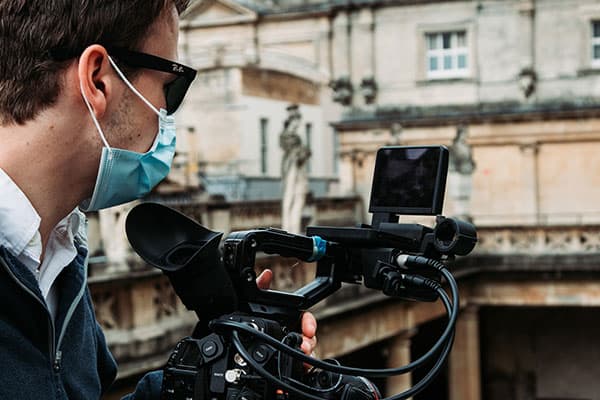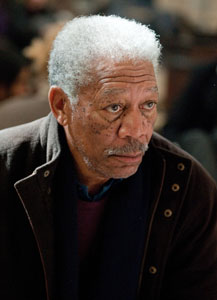
COVID-19 has blindsided the filmmaking world. The entertainment industry is set to sustain $160 billion in losses over the next five years, according to market research by Ampere. Production has halted. Theaters have shuttered. Physical festivals are cancelled. And with no clear pathway out of the virus, efforts to get back to work are tenuous at best. But even a pandemic like this can’t stop storytellers from storytelling.
Whether you’re making documentaries, music videos, or collaborative collections of shorts, there are ways to keep production moving, and transforming, during the pandemic. Here’s what some filmmakers are doing.
Shift to Socially-Distanced Green Screens
Virtual shoots against green screens are social-distance-friendly and can save some upfront costs. You don’t have to build sets, secure locations, or arrange for transportation of the cast and crew. But it makes the post-production process longer and more expensive. Whether it’s a net financial gain or loss depends on the demands of the shoot, and will vary from project to project. But it will put a different dynamic on the process.
Sir Ian McKellen said in a 2018 interview he was “miserable” filming on a bunch of green screens for The Hobbit, whereas he enjoyed “every single moment” filming at Lord of the Rings location shoots. “It may be my impression but I don’t remember a green screen on ‘The Lord of the Rings,’” he said. “If Gandalf was on top of a mountain, I’d be there on the mountain.”
Green screens are not necessarily worse. Some actors may prefer the special demands that green screen acting places upon the imagination, and it opens up creative control over environments. But it is different, and will have repercussions even as far as the casting process.
Similarly, many studios are populating environments with digital extras instead of hired actors.
Incorporate Challenges and Obstacles Into Your Story
In late 2019, Missouri filmmaker Matt Schacht was developing a film about the 50th anniversary of the Missouri Symphony. It turned into a film about how the symphony deals with a pandemic.
“The great thing about documentaries and why a lot of people are so drawn to them is that they give you an intimate look into someone’s life or a look behind-the-scenes of how an industry or corporation operates. Documenting reality means just that – show the audience what is happening, and if that means including the challenges of filming during a pandemic, so be it,” says documentary filmmaker Jia Wertz. “You’ll notice so many shows and movies incorporating Zoom calls in filming. Tiger King’s eighth episode titled ‘Tiger King and I’ was entirely shot over Zoom, and it wasn’t an issue, as the audience knows this is the reality we are all living in at the moment.”
Wertz’s documentary short Conviction was set to premiere at the Anthology Film Archives in Manhattan’s East Village this past April, but the premiere has been postponed due to theaters shutting down.
“In some ways the pandemic has really hindered the success of my documentary, with all the theaters shutting down, screenings being cancelled, and not having the benefit of live audience feedback. However, in other ways I’ve found it to be very beneficial, too. I have taken more online film classes than I can count and have been able to connect with so many other filmmakers that have been available since everyone is home,” adds Wertz.
“It’s a rollercoaster ride. Some days I’m really positive and enthusiastic and other days, not so much,” says documentary filmmaker Ramona Diaz. “It’s tough to be creative.” When COVID interrupted the festival tour of her film A Thousand Cuts, Diaz pivoted to gathering short films from filmmakers around the world that describe the variety of ways people are living with the coronavirus.
“We’re documentary filmmakers,” Diaz says. “This is what we do, we try to bear witness to the moment.” In the true spirit of the documentarian, Schacht, Wertz and Diaz are embracing the strangeness of the current moment instead of fighting it.
Proceed Carefully With Protocol and Plenty of Insurance
California and New York are tentatively reopening for shooting, with certain caveats. Production for the seventh Mission: Impossible film is scheduled to pick back up in August, after halting in February. According to reports, ViacomCBS and its subsidiary Paramount Pictures plan to shoot outdoor scenes first, as part of a new set of safety protocols.
“It’s going to be up to the insurance companies,” says DMG Entertainment CEO Dan Mintz. “That’s going to be driving a lot of this.”
If you happen to command the legal and insurance power of a global media giant like ViacomCBS, this might be a tenable option. But even in such a case, consider whether it’s really worth putting lives at risk. If you must move forward, make sure everyone is on the same page with detailed safety protocols. And don’t skimp on your insurance and legal protection.
The industry isn’t going away. It’s just changing. We don’t know what the new normal will look like on the other side of this pandemic, but we know those who keep adapting are the ones that will define it. There are ways to cope and continue with the craft even as we navigate this in between space. Most importantly, don’t lose that spirit of filmmaking creativity. Keep shooting. Keep documenting. Keep acting, even if it’s only in the mirror or on Instagram. The world still needs your stories.
Tina Mulqueen is the President of Kindred PR and the Executive Director of Cause Influence, a non-profit dedicated to expanding the digital footprint of important social causes.


